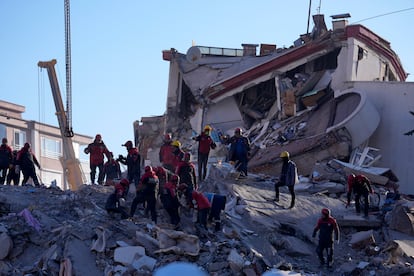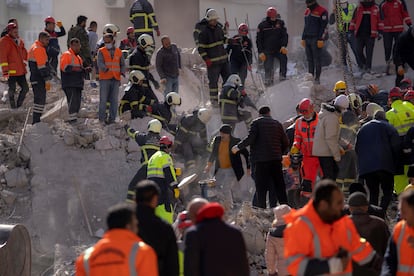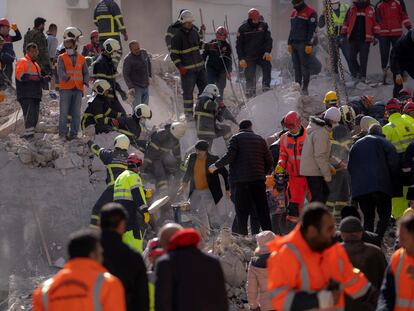Turkey and Syria earthquakes: ‘The population has to prepare for months of aftershocks’
Experts explain why the tremors were so devastating and what local residents can expect in the coming weeks

The devastation caused by the earthquakes in Turkey and Syria once again underscores the tremendous force that can be unleashed by these events and the risk associated with these hot spots. We asked seismologists for explanations as to their origin, impact, aftermath and best way to measure them with today’s modern tools.
Where and how exactly did the earthquake start? The main earthquake, of magnitude 7.8, did not occur in a single spot, even though it is shown that way on maps. “It was not instantaneous, nor was it [located] at one specific point, it propagated throughout the entire fault and lasted 30 seconds,” explains the seismologist Itahiza Domínguez, of Spain’s National Geographic Institute (IGN). “The size of the fault where the movement took place is 200 kilometers and the rupture moved along the entire fault. The spot where we have located the epicenter is the spot where the first seismic wave reached the seismographs.” However, the fractures and the trembling took place all along those 200 kilometers (124 miles), as the map below shows.
The earthquake took place after two tectonic plates rubbed horizontally, like the blocks of a puzzle. The energy of the collision between the two plates was concentrated at that spot until it broke and released the energy. The subsequent aftershocks of the initial earthquake occurred along that fault, called the Eastern Anatolian fault, which is more than 500 kilometers (310 miles) long.
Was the second big 7.5 magnitude quake an aftershock of the first? Nine hours after the first quake, another 7.5 magnitude quake hit further north. Some definitions of the word “aftershock” exclude earthquakes that are similar in size to the main one, or occur far from the initial rupture. In this case, the second quake took place on a different fault (the Sürgü and Çardak fault) and was similar in magnitude to the first one. The issue thus becomes a semantic or academic one, with specialists divided between those who consider it an aftershock and those who suggest that it is a different seismic event, driven by the initial one.
And how long will the aftershocks last? In any case, both the 7.8 earthquake and the following 7.5 tremor generated significant aftershocks, making rescue efforts difficult and putting more buildings and infrastructure at risk. So far there have been around 135 major aftershocks, above magnitude 4, and hundreds of smaller ones. “It cannot be said categorically how long these will last, but the rearrangement of the plates can last for months and even years. The population has to be prepared for months of aftershocks,” warns the seismologist Gina Villalobos of the Tamaulipas Autonomous University in Mexico.
Other experts agree. “We can expect them for more than six months. The magnitude of the aftershocks will decrease, and the thrusts will continue, causing the plates to slide until another blockage occurs,” adds Luis Cabañas, of Spain’s National Seismic Network.

How do we measure the force of an earthquake? “The two parameters used to measure earthquakes are magnitude and intensity,” says Villalobos. “Magnitude expresses the net energy that was released: a magnitude 9 earthquake releases 32 times more energy than a magnitude 8 earthquake, regardless of where it happens or who is affected.”
Intensity, on the other hand, measures the social and environmental impact: people affected, damage to buildings and so on. So even though the 7.8 quake released three times as much energy as the 7.5 tremor, both are in the same category in terms of intensity: IX, very destructive. Intensity is measured on the Mercalli scale, which uses Roman numerals and ranges from I (very weak) to XII (catastrophic).
Could it have been predicted? Large earthquakes can be expected, because we know where the most troublesome points on the planet are, such as the San Andreas fault in California, which is structurally very similar to the one that caused the quakes in Turkey and Syria. But it is impossible to know when they will take place. This did not prevent a group of Italian geologists from being sentenced to jail in Italy for assuring that “there is no danger” shortly before the 2009 earthquake in L’Aquila. “Earthquakes cannot be accurately forecast, so preventing the consequences depends on preparedness [for example, through earthquake-resistant infrastructure] and an efficient response. Unfortunately, resilient infrastructure is patchy in southern Turkey and especially in Syria, so saving lives now largely depends on the response. The first 24 hours are crucial to finding survivors; after 48 hours, the number of survivors decreases enormously,” explains Carmen Solana, Reader in Volcanology and Risk Communication at the University of Portsmouth, in statements to Science Media Center.
Why has it caused so much devastation? “In this case, it has been very intense because it has occurred in a highly populated area and very close to the surface, so there was no margin for the energy to dissipate,” says Villalobos. “Then you have to factor in old buildings without earthquake-resistant construction requirements, and with each earthquake they have been weakening.” Added to these factors is the fact that the first earthquake took place before dawn, catching most people sleeping inside buildings.
The Mexican expert compares it with the 1985 quake in Mexico City, which resulted in thousands of deaths and led authorities to introduced new rules. In Chile, she adds, large earthquakes are not a major problem because preparedness measures are in place. In Turkey, she surmises, there may have been a case of what she calls “social myopia: neither I nor my parents experienced it, therefore I don’t think it will happen in my lifetime.” But Villalobos warns that “decisions should be made thinking about the geological time frame, not the anthropological one.”
Magnitude, scale, Richter, degrees... These earthquakes, according to the measurements we currently have, are of magnitude 7.8 and 7.5. Degrees are not used to describe them, and they are not on the Richter scale, but on a more precise one called “moment magnitude” scale. “The Richter scale is more appropriate for smaller phenomena and for instruments from the time it was created [1935]. Anything above a magnitude 6.5 is measured poorly with this system. For bigger earthquakes the Richter scale is useless and it is better to use the ‘moment magnitude’ scale.”
Why did it occur in that part of the world? “Turkey is one of the most active seismic regions in the world because it is crossed by two major faults: the North Anatolian fault, which borders the Eurasian plate, and stretches from the Armenian Plateau to the Sea of Marmara; and the eastern Anatolian fault,” explains Rosa María Mateos, a geologist at Spanish National Research Council (CSIC).
Sign up for our weekly newsletter to get more English-language news coverage from EL PAÍS USA Edition
Tu suscripción se está usando en otro dispositivo
¿Quieres añadir otro usuario a tu suscripción?
Si continúas leyendo en este dispositivo, no se podrá leer en el otro.
FlechaTu suscripción se está usando en otro dispositivo y solo puedes acceder a EL PAÍS desde un dispositivo a la vez.
Si quieres compartir tu cuenta, cambia tu suscripción a la modalidad Premium, así podrás añadir otro usuario. Cada uno accederá con su propia cuenta de email, lo que os permitirá personalizar vuestra experiencia en EL PAÍS.
¿Tienes una suscripción de empresa? Accede aquí para contratar más cuentas.
En el caso de no saber quién está usando tu cuenta, te recomendamos cambiar tu contraseña aquí.
Si decides continuar compartiendo tu cuenta, este mensaje se mostrará en tu dispositivo y en el de la otra persona que está usando tu cuenta de forma indefinida, afectando a tu experiencia de lectura. Puedes consultar aquí los términos y condiciones de la suscripción digital.
More information
Últimas noticias
Maduro to be tried in the US for narcoterrorism and corruption
Maps of the US attack on Venezuela: Targets, airspace and deployed fleet
Venezuelans in exile: ‘This could be the end of a very dark chapter for Venezuela, but also the beginning of a time of uncertainty’
Key points of the military attack on Venezuela: Early morning bombings and a ‘captured’ president
Most viewed
- Alain Aspect, Nobel laureate in physics: ‘Einstein was so smart that he would have had to recognize quantum entanglement’
- David King, chemist: ‘There are scientists studying how to cool the planet; nobody should stop these experiments from happening’
- Mexico completes its trade shift with the entry into force of tariffs on China and countries without trade agreements
- Reinhard Genzel, Nobel laureate in physics: ‘One-minute videos will never give you the truth’
- Oona Chaplin: ‘I told James Cameron that I was living in a treehouse and starting a permaculture project with a friend’











































